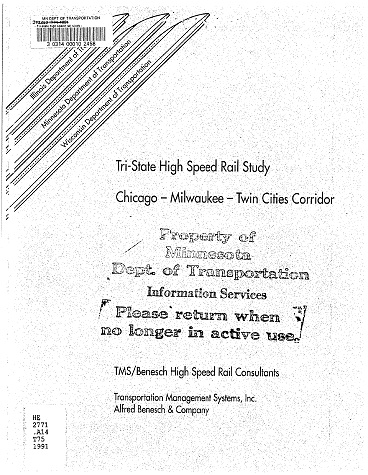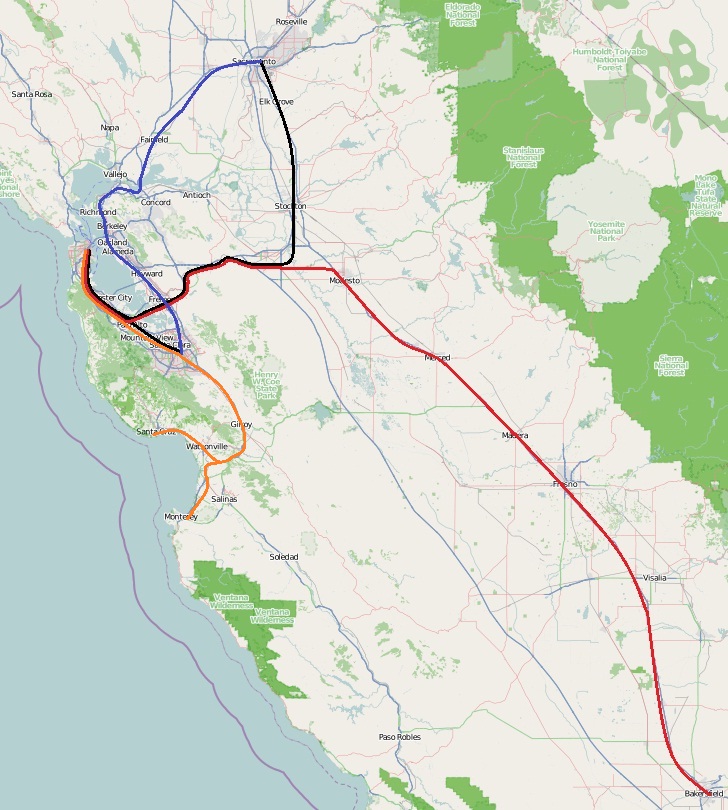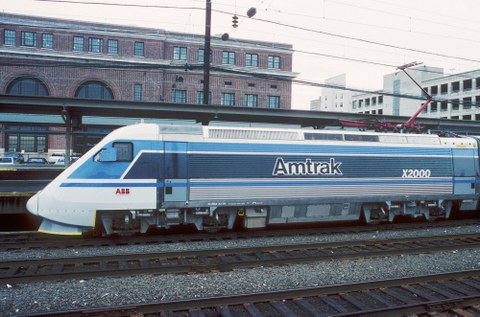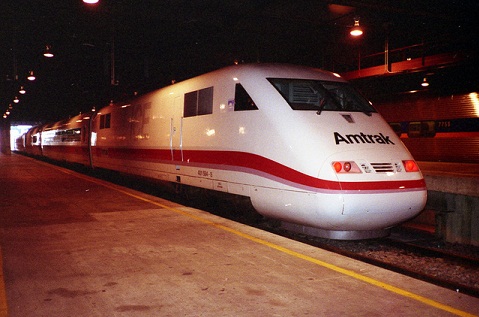1991 - 1994
The early 1990s started with much the same style as the 1980s finished; largely Amtrak losing money every day from normal operations. After continued demands to spend money more wisely, Amtrak announced the closure of several long distance routes that were among the most expensive in the country to run. High profile closures (officially called "reduction of service" that usually meant one train running per week) included Sunset Limited, that ran from Orlando to Los Angeles and Pioneer that ran from Chicago to Seattle. These services were operated at a loss of around $200 per passenger; simply not worth running, despite the public grumble about further service cuts. In return, Amtrak managed (in what was described as a "strictly one-off") to gain funding for a large scale modernisation of the North East Corridor, in recognition of the "core status of the North East Corridor to our nation's economy". Amtrak's pleas for funding help to do so brokered largely on 2 main points: that the infrastructure needed updating after decades of deferred maintenance - from far longer then Amtrak had owned it, and that once upgraded, the train service would be able to properly compete with other transport forms and make a profit.
Although much of the rail infrastructure had been updated in the 1970s (largely new signalling, electrification and rails), bridges and other heavy works had continued to be maintained as cheaply as possible due to the large capital cost in fixing the issues. A US Congress Bill eventually passed providing some funding for rebuliding some of the most at-risk bridges and structures, in return for increased service cuts. Desert Wind, and Texas Eagle were the next to be cut; again services that lost approaching $200 per person in service. Both were also services that had other services largely running alongside them, mitigating the social impact of the cuts.
An archived copy of the Tri State High Speed Rail Study
However, in a growing sign of the times, it would continue to be projects that were funded by State governments that Amtrak focussed upon. The "Tri-State High Speed Rail Study", initiated by Illinois, Wisconsin & Minnesota and released in 1993, advocated for a thorough modernisation of the Chicago - Milwaukee - Eau Claire - St Paul - Minneapolis route that Amtrak ran. Although various analyses had been conducted, it turned out that the best value for money would be 125mph operation, with little advantage coming from investing in faster speeds due to the vastly increased costs associated with relaying railways for straighter alignments. Although Amtrak, in consultation with the Study, advised that it would be unable to contribute many funds towards modernisation of the route, Amtrak did produce an interesting update at the time.
Amtrak was studying the upgrade of trains of the North East Corridor to support the faster speeds that would soon be available, and to allow faster turn around times of the trains in the terminus stations (particularly JFK Airport were cramped conditions made life difficult, despite the ever growing popularity of the service pushing at it's capabilities). If Amtrak upgraded the trains on the NEC, it would be willing to overhaul the AEM7 locomotive hauled trains for use on the Chicago - Minneapolis service if it was electrified, therefore avoiding the need for purchasing new trains. The 3 States involved would soon agree to fund a modernisation of the route to allow 125mph running, with electrification being dependent on Amtrak providing AEM7 locomotion.
In New York, interest was renewed in expanding express services to serve upstate New York, potentially all the way to Buffalo. The Maple Leaf service already ran most of this route, and on to Toronto, but was slow and not in great shape financially. This route was used by several freight trains per day, but in days gone by the route had been quadruple tracked, so there was ample opportunity to redo this, and allow a combination of operations in some manner, and an official report was commissioned into the potential opportunity to bring express services back along the old Water Level Route. The report, released in 1994, advocated for a full Amtrak service all the way to Buffalo. Although the report did also advocate using the West Side Line to run from the Buffalo/Albany into New York Penn and then on to New York JFK Airport, unfortunately capacity was sorely lacking at the cramped JFK Airport station, hindering further services. The service had exceeded Amtrak's expectations, and now there was insufficient capacity at the airport for further growth; Amtrak now had to look for innovative solutions.
Elsewhere in the State, construction began underneath New York in expanding the PATH system, in two ventures jointly funded (separately) with New York and New Jersey States. The extension, from 33rd Street Station, ran through a new underground station at Grand Central Terminus, and up into the running tunnels north (primarily towards New Rochelle), with passive provision for a second branch to the north west of 33rd Street Station. An extension to the south would run from Newark to Newark Airport and on to Middlesex in New Jersey
In the Mid-West, the Chicago O'Hare link opened in 1994, providing a fast service between Chicago Union station and ORD Airport. Several commuter services were rerouted to run through the airport, as well as the express services from Milwaukee and Minneapolis - which ran on to Indianapolis and Cincinnati / Louisville, providing check-in & baggage services to all the large cities (Minneapolis, St Paul, Eau Claire, Milwaukee, Chicago, Indianapolis, Cincinnati & Louisville).
Northern California rail services
California was already a step ahead; a large financial spend had been authorised at the end of the 1980s, with Amtrak now beginning to reap the operational benefits. Of primary importance were the pass through the Diablo Range past Pleasanton and Livermore, much expanded from the previously slow freight route, and the renovated Dumbarton Rail Bridge. Rail services were reconfigured in North California to provide express services, and new commuter services around the area, with all services allowing direct access to San Francisco city centre and the international airport.
The other venture that Amtrak embarked upon, was an investigation into new trains for it's NEC, as modernisation work progressed to remove many of the speed restrictions across bridges and other infrastructure which severely slowed down it's services. This time, Amtrak would carefully consider the various choices it had, with both the Swedish X2000 and German ICE conducting demonstration runs on the North East Corridor in 1994.
Swedish X2000 and German ICE1 trains on demonstration runs in the United States
Although the FRA almost threw a massive curveball at Amtrak with new requirements for crashworthiness, Amtrak managed to negotiate their way out of them. One of them, an FRA mandate that locomotives must be able to withstand a 400 tonne collision was waived as it was for the AEM7 locomotives (which withstood a 250 tonne collision), on the basis that express running would only take place on dedicated tracks with no freight on. Amtrak was largely able to agree to this due to the majority of the NEC being quadruple tracked, therefore the freight never ran on the express tracks in the middle.
--------------------------------
Notes: Back in the swing of things now! State-funded efforts are going to be the main thrust in the 1990s, with the exception of the NEC trains really. OTL, the Mid-West and New York did study hgih speed rail efforts, and the New York one semi-produced results. A bit of a push here due to the snowballing butterflies, and these will herald results. However, Amtrak has been a victim of it's own success at JFK, and this will need addressing - I've got plans for this.

Suffice to say, airline history will be roughly the same in this TL as OTL - Pan-Am will go out of business in the 1990s, although I wonder if they might merge with American Airlines (Pan American Airlines?). Just a thought!
For the Mid-West, the original rail study only contemplated diesel power at 125mph, or electrified power at 185mph. However here, the prospect of just inheriting a bunch of Amtrak AEM7 locomotives to operate trains proves to be a large incentive to electrifying the route, as is eliminating diesel trains from the O'Hare Airport Tunnel. And a note on crashworthiness, OTL, it's requirements like this 400-tonne head on collusion that made the Acela as heavy as it is. OTL, the AEM7 were only good for 250 tonnes approximately, so I don't see why this can't be followed through for this TL's version of Acela.





